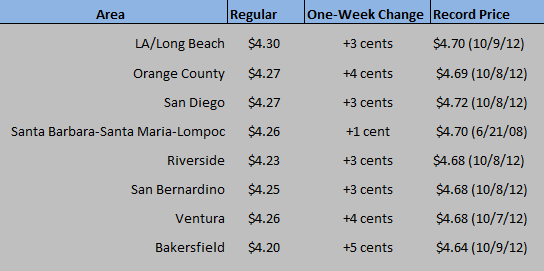California motorists will be paying a little more to fill up their tanks starting Thursday as the state’s latest gas tax rose overnight.
The automatic increase is due to Senate Bill 1, a legislative package that was signed into law in 2017 and incrementally raises the fuel excise tax each year in part to help fund road and bridge repairs. That means the state’s already highest-in-the-nation gas tax climbs from 50.5 to 51.1 cents per gallon.
The legislation also included an annual vehicle fee; that combined with the taxes are expected to raise more than $5 billion in revenue annually for transportation projects.
As of Thursday morning, the average price for a gallon of regular unleaded in the Golden State was $4.28, an increase of about three cents since one week ago, according to AAA statistics.
In Los Angeles, the average cost of 87-octane (regular) gasoline was somewhat higher, about $4.31 per gallon. Orange, Riverside, San Bernardino and Ventura counties all had fuel prices that were slightly lower than the state’s average.
But it’s not just California that’s seeing a surge in gasoline costs — the nationwide average is $3.12, currently the highest of the year. The spike comes as tens of millions of Americans prepare to travel for the Fourth of July holiday.
“Today, 89% of U.S. gas stations are selling regular unleaded for $2.75 or more. That is a stark increase over last July 4 when only a quarter of stations were selling gas for more than $2.25,” AAA spokesperson Jeanette McGee said in a news release earlier this week. “Road trippers will pay the most to fill up for the holiday since 2014.”
The automobile club forecasts that a record-breaking 43.6 million Americans will travel to their Independence Day holiday destinations by road between July 1 and July 5. Approximately 4.6 million Californians will hit the roads during that period, including nearly 3 million in the Southland.
Gas prices are also much more expensive compared to last year amid an increase in the cost of crude oil. AAA cited rising oil demand worldwide, global confidence in the coronavirus vaccine rollout and COVID-19 travel restrictions being relaxed as the three main factors for the surge.
Unfortunately for drivers, prices at the pump aren’t forecast to decrease anytime in the near future, with analysts predicting soaring costs will linger through summer.













